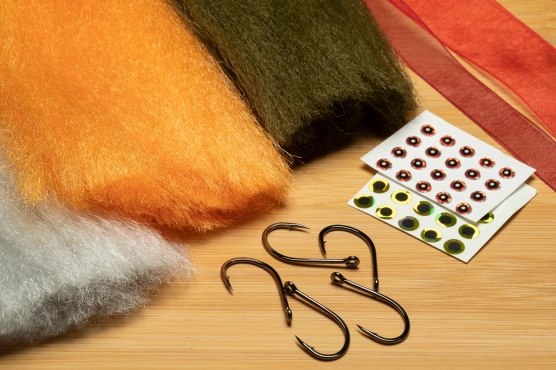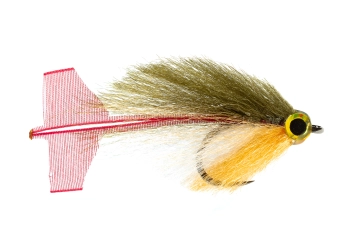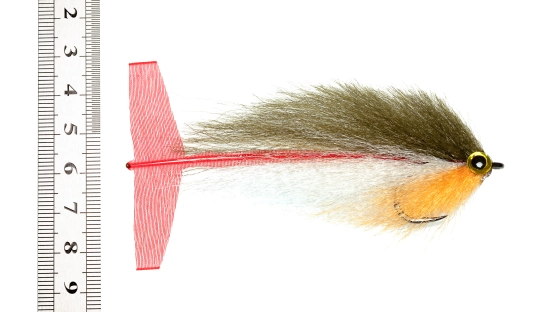A mobile tailed baitfish pattern tied with organza and synthetic fibres
I’ve previously used organza ribbon to make the tails and bodies for a number of fish imitations like my Micro Minnow. These patterns all use one or more triangular pieces of ribbon welded together at one end with a lighter flame. The Ribbontail Baitfish takes a different approach using two pieces of trimmed ribbon fused back-to-back to form a mobile tail for a baitfish tied with synthetic fibres.
You can buy organza ribbon by the metre or the spool in craft shops or online in widths from 3mm to 25mm. Since an organza fish tail is made with two pieces of ribbon you can make tails from 6mm to 50mm to suit a wide range of sizes of baitfish imitations.
To make a tail first cut two suitable lengths of organza ribbon for the size of fish you are tying. Cut along close to one woven edge as shown in the diagram (1), then cut in from the other end and across the ribbon (2 & 3) to remove a rectangular section at the end. Complete the tail shape with an angled cut (4) intersecting with the first cut. Repeat the cuts on the second piece of ribbon, put the two pieces together, hold the ends with metal tweezers and fuse the ends together with a flame.
The body of the Ribbontail is formed from bunches of synthetic fibres tied in along the shank. There are many suitable fibres available, including Enrico Puglisi (EP) fibres, Semperfli Predator Fibres, Hemingway Streamer Fibres and Congo Hair. Prices and geographical availability vary, so use those you can get easily without paying a fortune. The important feature of all synthetic streamer or predator fibres is that they don’t absorb water, so you don’t end up trying to cast the equivalent of a wet sock.
The key to tying a good-looking fibre fish is using monofilament thread which disappears when coated with varnish or UV-resin and blends into the coloured fibres of the body. There are a few suppliers of mono-thread including Danville, UTC, Veevus and UNI. UNI-Mono comes in two sizes which is useful for tying big or little fish. Again, use whichever you can get hold of where you live.
If you are not familiar with the techniques for tying in the body fibres and trimming to shape, I recommend you watch Charlie Craven tying an EP Minnow which covers everything in detail.
Synthetic streamer fibres are available in a wide range of colours, so choose combinations to imitate your chosen baitfish. The one shown here is tied to represent the small wrasse and pollack that live among the rocks and kelp around the rocky shores of west Wales where I do my saltwater fly fishing in the spring and summer.
Tying in bunches of fibres is much like applying dubbing; less is better. The number of fibres you need is surprisingly small and if you use too much, they’re just going to end up in the bin when you trim the fly.
When tying bigger fish with larger tails treating the ribbon with flexible acrylic varnish or UV-resin makes the cutting process easier and maintains the shape of the tail. Cut a length of ribbon twice the desired length of the tail and lay flat on a piece of paper or card. Apply a small amount of varnish or resin over the middle section of the ribbon and use the edge of a piece of card as a squeegee to spread a thin coat along the ribbon for twice the length of the tail fin. Pick up the ribbon and place it on its edge to dry, or cure with a UV torch. Cut the coated ribbon in half and then trim the two pieces to form the tail.
If you prefer, the top and bottom sections of the tail can be different colours, either using sections of different coloured ribbons or by shading part of a light colour ribbon with a dark marker pen.
Nick Thomas
Ribbontails are not just for saltwater fishing, the same technique can be used with narrow organza ribbon to make streamers for fishing rivers or lakes. With different colours of ribbon and fibres you can imitate minnows and other small species or the fry of larger ones.
- Log in to post comments


















